The
plunder of the empires of the Americas was to good purpose – it
allowed Spain to finance religious persecution in Europe for
over a century. Spanish wars of conquest included laying
waste much of the Netherlands and a disastrous attempt to invade
England. By destroying diverse cultures in the New World the
Christian conquerors were able not only to eradicate civilizations
more ancient than their own but also were
able to senselessly erase a vibrant artistic legacy and even
scientific knowledge. In their stead the Christian adventurers
imposed a racist tyranny and an alien god. Millions were enslaved
but their short and brutalized lives had at least known Jesus.
Wasn't
that worth a little suffering?
World's
Collide: "Reconquista" to "Conquista"
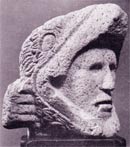
Aztec
Eagle Knight (National Museum, Mexico).
A warrior
aristocrat, much like his Spanish counterpart. Shared
the same conviction of a divine mission to rule the
world.
Unfortunately
for the Aztecs their military technology simply did
not match that of the invaders and their "flower
war" culture aimed at capturing sacrificial
victims not genocide. |
|
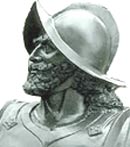
Christian
knight – the Conquistador.
700 years of warfare
had produced a warrior culture contemptuous of other
ways of life.
The
final conquest of Iberia left a hard core of professional
soldiers without employment – but then the "Indies" beckoned.
Equipped
with "Toledo steel" (developed by the Moors),
in ships (based on Islamic designs) and mounted on
Andalusian horses (bred by the Arabs), these avaricious
brigands would commit any atrocity in the pursuit
of gold. Priests
were with them, every step of the way. |
Before
the Conquest
Long
before the Iberian tribes learned civilization from the Phoenicians,
Greeks and Romans, ancestors of the Aztecs – Olmecs and
Toltecs – were building great cities of stone. While the
forebears of the Spanish knights cowered in the mountains of
the Astorias and most of Spain flourished under the Moors, the
Maya civilization of Central America entered its classic period.
Two hundred years before Colombus showed up in the Caribbean
Mayan traders were colonizing the islands.

Aztec doctor
(Codex Florentino).
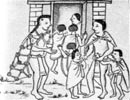
Boys taken
to Aztec school or 'Calmecac' (Codex Florentino).
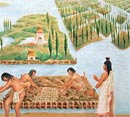
Aztec floating
gardens or chinampas produced maize, beans and other
crops to feed the growing metropolis.
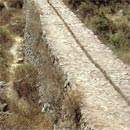
Inca road,
with central water channel.
Over 14,000
miles of Inca road, much of it clinging to mountains
at high altitude, linked peoples all the way from equatorial
Quito to the southern deserts of Chile.
Ciezo de Leon,
an early chronicler of the Spanish conquest, reported "everywhere
it was clean swept and kept free of rubbish, with lodgings,
storehouses, temples to the sun, and posts along the
way."
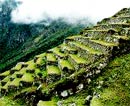
Inca terraced
gardens – vastly superior to the barren land
of Estremadura where Pizarro recruited his desperados. Beyond the promises of easy wealth was the enticement of "easy women". Indian girls were made available without the constraints of Christian marriage, many transported to Europe where they would be sold as prostitutes. 
|
|

Superb
Aztec gold work– almost all went into the Spanish
melting pot. For the natives of the Americas gold had
aesthetic rather than monetary value.
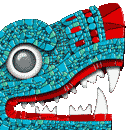
Aztec turquoise
mosaic serpent. Idolatry?
Artisans
of the Devil?
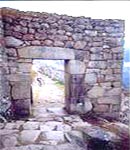
Entrance
to Machu Picchu. Expert stone work of the Inca continue
to fascinate.
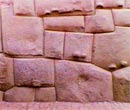
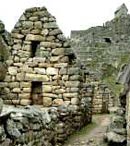
|
Dissolute
Pope parcels out the Whole World
"Wherever
Christians have passed, conquering and discovering, it seems
as though a fire has gone,
consuming everything."
– Pedro
de Cieza de León (c.
1550, Crónica del Peru, Primera Parte, 2.66)
No sooner
had the Americas been discovered than Alexander VI, the notorious
Spanish Borgia Pope, divided all "heathen
lands" from pole to pole between the Christian kingdoms
of Spain and Portugal. The Papal Bull Inter Caetera,
issued on May 4 1493, charged his Castilian cronies with a special
mission:
"Moreover we command you in virtue of holy obedience that,
employing all due diligence in the premises, as you also promise
–
nor do we doubt your compliance therein in accordance with your
loyalty
and royal greatness of spirit – you should appoint
to the aforesaid mainlands and islands worthy, God-fearing,
learned,
skilled,
and experienced men, in order to instruct the aforesaid inhabitants
and residents in the Catholic faith and train them in good
morals."
A year later
(1494) the Treaty of Tordesillas placated a disgruntled
Portugal by moving the demarcation line further west, rewarding
Portugal with Brazil. But
in 1580 Philip II of Spain also became
king of Portugal, making the papal global carve-up somewhat academic
and Spanish claims to the Americas total. No other nation
had a permanent settlement on the shores of the New World
to contest
the claim.
Ignorant
of such distant power broking were perhaps a hundred million
indigenous natives of the Americas, blissfully unaware of the
unholy crusade about to brutally sweep away their world forever.
Across the ocean the cohorts of Christ, having reduced
Europe by the carnage of religious warfare, were
about to dip their hands in blood in a New World.
The
Indies: Christian enthusiasm
for "Enjoyment"
"Your
Highnesses will win these lands, which are an Other World,
and where Christianity will have so much enjoyment, and
our faith in time so great an increase."
– Colombus
to his patrons Ferdinand
and
Isabella, 1498 (Morrison, et al, p22)
1492 Colombus lands on the island of Hispaniola in the Indies.
He trades glass beads for gold and leaves a small settlement.
1493 Colombus's second fleet of 17 ships reconnoiters Jamaica and southern Cuba.
1498 Colombus, with colonists emptied from Spanish prisons,
makes landfall at Trinidad. The Hispaniola colony is relocated
on
the south
coast at San Domingo by his brother Bartholomew.
1514 Panfilo de Narvaez conquers Cuba. The priest Bartolomeo
de las Casas records a catalogue of Spanish torture and
barbarity.
1500-1520 Conquest of Greater Antilles is complete.
Within
a generation the Caribs and Arawaks, a native population
of perhaps 250,000, forced
into slave labour in the gold mines, were virtually wiped
out. To
take their place, beginning in 1510,
slaves were brought in from Guinea in West Africa.
But disappointment with the lack of gold prompted the Spanish
to introduce sugar
cultivation. Harsh, labour-intensive plantation
agriculture,
pioneered by the Portuguese in Sâo Tomé, was
now established in the Americas. The conquistadors themselves,
warriors
not farmers, moved on, to cause ever greater ruin.
Slash
and Burn
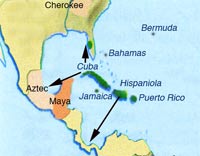
|
Having exhausted
the Caribbean Islands of a limited quantity
of
pearls and gold and eradicated
the entire native population, the Spanish conquistadors
assaulted the mainland.
In
their wake, the islands of the Indies were
left to be exploited by a colonial
elite.
Plantations were worked by brutalised
slaves imported from African. The sugar crop
was sold in European markets.
English
colonies copied Spanish plantation-style
agriculture, first in the Lesser Antilles
and then in Virginia.
|
|
Destruction
"Pizarro
replied that they had come ... to let them know
that the idols they worshipped were false, and
that to save their souls they had to become Christians
and believe in the God the Spanish worshipped."
– Michael
Wood, Conquistadors, p120
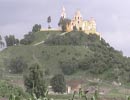
Terror
tactics compensated for the small numbers of
the conquistadors.
|
Shock
and Awe
Cholula
pyramid, now sporting a Catholic church on
the platform that once held an Aztec temple.
Cholula,
with a population of 100,000, was the second
city of the Aztec empire. It had thrived
for more than a millennium.
In
1519, Cortés chose Cholula to demonstrate
his Christian credentials. He massacred several
thousand unarmed members of the Aztec nobility
in the central plaza and then burned down
much of the city. What
a guy! |
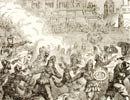 |
Weapons
of Mass Destruction
The
arquebus – a primitive, bulky gun – and
the crossbow were more than sufficient to
terrorize the lightly armed American aboriginals. |
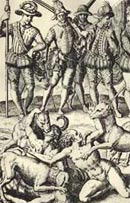 |
Thrown
to the Dogs
War
dogs provided an especially frightening tool
of war. Greyhounds and mastiffs were used
most commonly, kitted out in their own quilted
armour. The dogs were often trained to attack
their victims in the abdomen and genitals.
They were fed human body parts to encourage
their killer instinct.
|

|
Germ
warfare

Aztec
doctor confounded by unknown disease
(Florentine codex, c 1570)
|
Smallpox was especially catastrophic for the natives
of the Americas. The
smallpox pandemic began in Hispaniola in December
1518. It spread to Mexico in 1520, along the
Caribbean coast 1525-7, and reached Peru by
1527. The following year Wayna Capac, "Unique
Inca" and paternalistic ruler of his bronze
age empire, dies of the pox.
The Indians were vulnerable to a whole range European diseases: smallpox, diphtheria, influenza, cholera and measles among them.
|
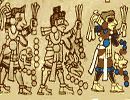
|
Cultural
Genocide
The
first thing Catholic priests did upon discovering
Mayan and Aztec books was to burn them. The
priests declared that the codices were "written
by the devil."
The
Church took over Indian "re-education",
with different monastic orders colonizing
specific localities. The orders offered ambitious
young men a colonial career whilst maintaining
a semblance of "mission" and civilization.
"Eradication
of idolatry" meant the wholesale destruction
of entire cultures. Pity
about the genocide. |
Central
America: The Lure of Gold
1502
- 1504 On his fourth voyage Colombus explores the Central
American coastline and encounters Maya traders at Bay Island
in the Gulf of
Honduras. In
1508 the first two Spaniards go ashore in Yucatan. In
1507 "America" appears on European maps for the first time.
1510 A settlement is established on the isthmus of Panama. In 1511
several shipwrecked sailors are taken prisoner by the Maya. In
1513 Balboa crosses the isthmus of Panama and reaches the Pacific.
1517 From Cuba, Francisco Hernandez de Cordoba explores the
Yucatan coast. The following year
Juan de Grijalua explores the coast of Mexico.
1519 From Cuba, Hernan Cortés lands at Veracruz. He rejects
envoys
with gifts from Moctezuma II and advances on the high plateau
of Tlaxcala.
At Cholula Cortès massacres the local chiefs. With the help
of native allies Cortes reaches Tenochtitlán
and takes Moctezuma hostage.
Cortes wrecks the great pyramid
before withdrawing.
1521 After
a 93-day siege Cortes takes and destroys Tenochtitlán.
1528 Francisco
de Montejo lands in Yucatan. He wages a 14-year struggle
with the Maya before establishing his capital at Merida.
1542 Pedro
de Alvarado takes the Mayan kingdoms of Cakchiquel and Quiche.
1543 Spain institutes annual treasure convoys.
1697 Martin de Ursua inflicts final defeat of Maya at Tayasal.
South
America: Peruvian empire for pious gangsters
1526 Francisco
Pizarro, already enriched by slave-holdings in Panama, leads
mercenaries into Colombia. Their terror
tactics are unflinchingly cruel but to little avail and the
expedition has to be rescued.
1529 Charles
V of Spain grants a licence to Pizarro to "discover and conquer
Peru." When the invasion begins in 1532 the Inca empire,
weakened by disease, is also wracked by civil war. The "Unique
Inca" Atahuallpa is captured, forcibly baptized and garrotted.
1535 The
Pizarro brothers establish a coastal capital of Lima and
begin shipping
gold back to Spain. Rivalry with fellow Spaniard Almagro
leads Pizarro to execute his former companion. Almagro's son
takes his revenge by murdering Pizarro.
1536 Great
Inca revolt is followed by resistance in Vilcabamba until
1572 when the last Inca, Tupac Amoru, is captured and executed. |
Enslavement: "Slavery
is God's mercy" says Christian saint
"Because
of the sin of the first man, the penalty of servitude was inflicted
by God on the human race; to those unsuitable for liberty he
has mercifully accorded servitude."
– Saint
Isidore of Seville
(Pierre Bonnassie, From Slavery to Feudalism
in South-western Europe, 1991, p57)
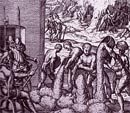
|
The
system of 'encomienda' gave Spanish settlers the right
to an Indian's labour in exchange for his "care and
religious instruction."
Thus,
conversion to Catholicism went hand-in-hand with enslavement
and early death.
The
conquistadors and their descendants used up the indigenous
people as slave labour in the gold mines of Mexico and
the silver mines of Peru. As a result, the plantations
of the Spanish/Portuguese empires had to import of six
and a half million African slaves. As many again were
required in other parts of the Americas. (For numbers
see Thomas, p805).
|
Genocide
Estimates of
the pre-Colombian population of the Americas vary but possibly
stood at 100 million – one fifth of humanity in 1492. Unlike
the Hollywood myth, most lived in towns and villages and were
not nomadic
hunters. Between
1500 and 1600 the population of the Americas halved. In Mexico alone, it has been estimated that the pre-conquest population of around 25 million people was reduced within eighty years to about l.3 million, European diseases largely to blame. It was an horrendous demographic disaster.
"Within decades
of Colombus's landfall, most of these people were dead and
their world barbarously sacked by Europeans."
– R.
Wright, Stolen Continents, p4.
Regret? Death bed remorse
"We found
those realms in such good order that there was not a thief
or a vicious man, nor an adulteress, nor were they an immoral
people, being content and honest in their labour...
We have
destroyed by our evil behaviour such a government as was
enjoyed by these natives... Owing
to the bad example we have set them in all things, that these
natives from doing no evil have turned into people who can
do no good...
There
is no more I can do to alleviate these injustices than by
my words ... in which I beg God to pardon me..."
– Masio
Serra de Leguizamon, the last
of the Conquistadors
Cuzco, 18 September
1589 (Wood, p274)
Voice
of the Dead
"You
tell me then that I must perish
like the flowers that I cherish.
Nothing remaining of my name,
nothing remembered of my fame?
But the gardens I planted still are young –
The songs I sang will still be sung!"
Huexotzin, Prince
of Texcoco, c 1484
(G. Jennings, Aztec)
Sources:
Michael Wood, Conquistadors (BBC, 2001)
Ronald Wright, Stolen Continents – The Indian Story (John
Murray, 1992)
Richard Hart, From Occupation to Independence (University
of the West Indies, 1998)
Hugh Thomas, The Slave Trade – The History of the Atlantic Slave Trade (Picador, 1997)
Divine, Breen, et al, America – Past and Present (Longman, 1998)
Noam Chomsky, Year 501 - The Conquest Continues (Verso, 1993
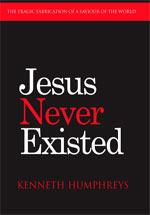
|
 |

|

|
Some fifty articles are now available as a book.
For your copy order:

|
|
'Save'
a friend e-mail this page
Copyright © 2005
by Kenneth Humphreys.
Copying is freely permitted, provided credit is given to the author and no
material herein is sold for profit.
|
